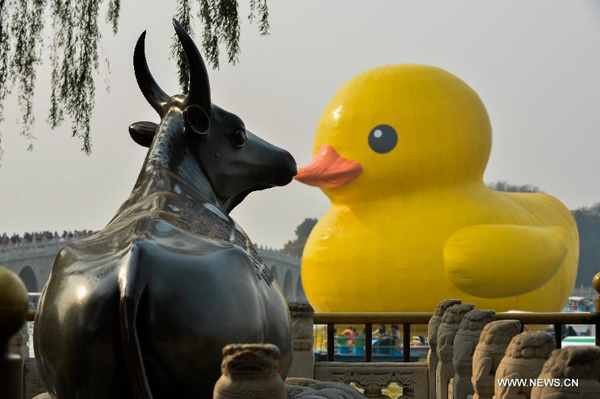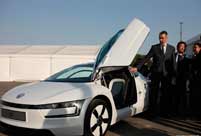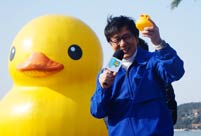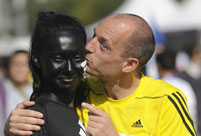 |
| Photo taken on Oct. 27, 2013 shows the giant yellow rubber duck, brainchild of Dutch artist Florentijn Hofman, in the Summer Palace of Beijing, capital of China. Sunday is the last day of the duck's tour in Beijing. (Xinhua/Li Xin) |
Five days after a giant rubber duck left Beijing, copycat versions and pirated stuffed toys are still popular across China.
During its one-month stay in the capital's Summer Palace from Sep. 26, more than two million people went to see the 18-meter-tall rubber duck, which was designed by Dutch artist Florentijn Hofman.
However, Chinese cities such as Hangzhou, Chongqing, Wuhan, Shenyang and Wuxi have all reported "ugly" copycat giant yellow ducks over the past couple of months.
On the day the real duck arrived in Beijing, a replica wearing a green vest and accompanied by seven inflated duck eggs appeared in the city's Yuyuantan Park.
The Beijing Design Week organizing committee, organizer of the giant rubber duck display, condemned such acts and stated "without written authorization, no organization or individual shall copy, exhibit or sell imitations and derivatives of the rubber duck in Chinese mainland."
As many as 30,000 official small rubber ducks were sold during the seven-day National Day holiday in the palace with prices ranging from 99 yuan (about 16 U.S. dollars) to 299 yuan, according to the committee.
But many more pirated ones were sold online or at other scenic spots in Beijing.
On Taobao.com, China's largest e-commerce platform, a search of "giant rubber duck" results in 100 pages of items. An online shop had a sales volume of more than 8,000 rubber ducks within a month.
The rubber duck generated ticket sales, catering and tourism as well as raised people's awareness of public art, said Du Wei, a management professor with Nankai University, in northern China's Tianjin.
But a netizen called "Yueqiu" pointed out on his microblog that the success of the giant yellow duck reflects the failure of China's innovation industry.
The overwhelming popularity of an inflated rubber duck also demonstrates the huge market potential of the country's creative industry.
"China's manufacturing capacity - huge as it is - cannot meet its people's needs for cultural or spiritual consumption," said Fan Hesheng, vice director of School of Sociology and Political Science of Anhui University.
"What we need is 'made by China' rather than 'made in China'," said Fan.
 Annual airshow kicks off in Houston
Annual airshow kicks off in Houston U.S. Navy Carrier Strike Group stages military exercises
U.S. Navy Carrier Strike Group stages military exercises Volkswagen showcases new energy vehicles in Beijing
Volkswagen showcases new energy vehicles in Beijing  How should we get married nowadays?
How should we get married nowadays?  Commentary:
Commentary: Jakie Chan sees Rubber Duck off in Beijing
Jakie Chan sees Rubber Duck off in Beijing Lingerie show dazzles Wuhan Motor Show 2013
Lingerie show dazzles Wuhan Motor Show 2013  Running in fun customs at Beijing Int'l Marathon
Running in fun customs at Beijing Int'l Marathon  Weekly Sports Photos
Weekly Sports Photos Unveil PLA air force base
Unveil PLA air force base  Say goodbye to tube-like apartment building
Say goodbye to tube-like apartment building Oriental education or western education?
Oriental education or western education? China in autumn: Kingdom of red and golden
China in autumn: Kingdom of red and golden National Geographic Traveler Photo Contest
National Geographic Traveler Photo Contest Chinese screen goddesses from Beijing Film Academy
Chinese screen goddesses from Beijing Film Academy Day|Week|Month